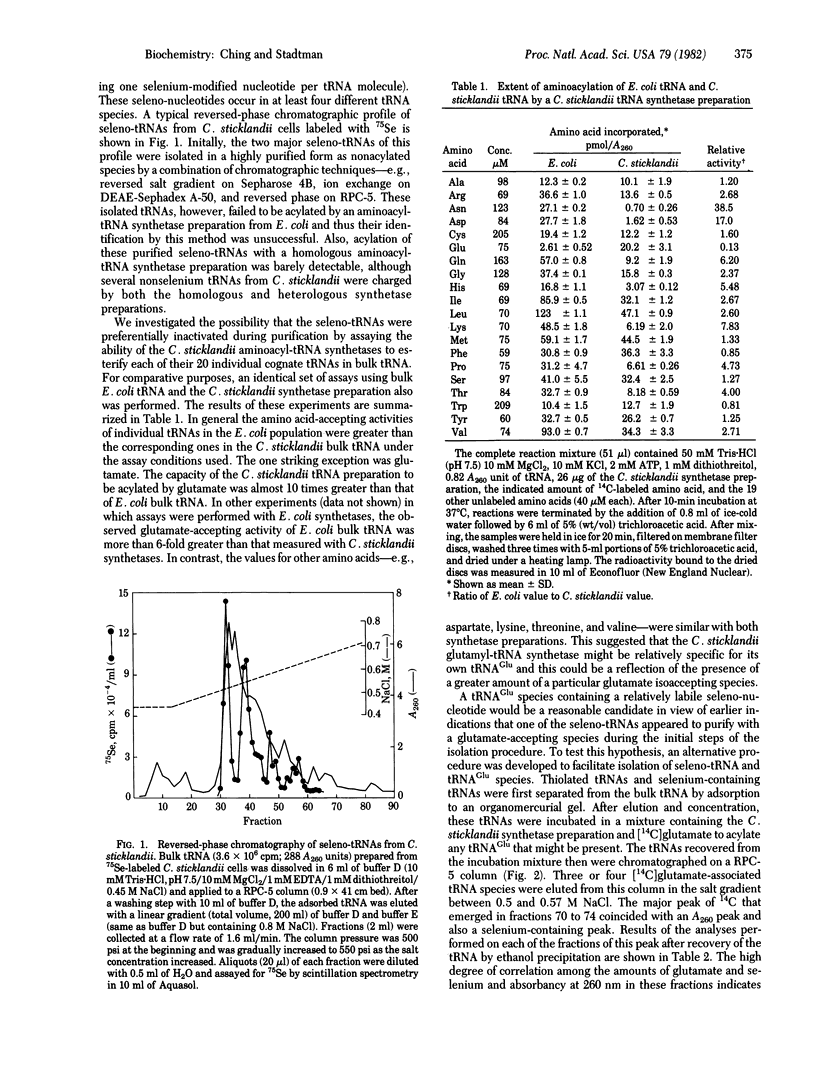Abstract
Selenium-containing amino acid tRNAs are normal components of several bacterial tRNA populations. In Clostridium sticklandii seleno-nucleotides occur in at least four different tRNA species which account for 5--8% of the total tRNA population. One of these has been isolated in a highly purified form and shown to be an isoaccepting tRNAGlu. Experimental evidence indicates that the presence of the seleno-nucleotide in this tRNAGlu is essential for its acylation with glutamate.
Full text
PDF



Selected References
These references are in PubMed. This may not be the complete list of references from this article.
- Abrell J. W., Kaufman E. E., Lipsett M. N. The biosynthesis of 4-thiouridylate. Separation and purification of two enzymes in the transfer ribonucleic acid-sulfurtransferase system. J Biol Chem. 1971 Jan 25;246(2):294–301. [PubMed] [Google Scholar]
- Chen C. S., Stadtman T. C. Selenium-containing tRNAs from Clostridium sticklandii: cochromatography of one species with L-prolyl-tRNA. Proc Natl Acad Sci U S A. 1980 Mar;77(3):1403–1407. doi: 10.1073/pnas.77.3.1403. [DOI] [PMC free article] [PubMed] [Google Scholar]
- Chiu N., Chiu A. O., Suyama Y. Three isoaccepting forms of leucyl transfer RNA in mitochondria. J Mol Biol. 1974 Feb 5;82(4):441–457. doi: 10.1016/0022-2836(74)90240-x. [DOI] [PubMed] [Google Scholar]
- Hatfield D., Portugal F. H. Seryl-tRNA in mammalian tissues: chromatographic differences in brain and liver and a specific response to the codon, UGA. Proc Natl Acad Sci U S A. 1970 Nov;67(3):1200–1206. doi: 10.1073/pnas.67.3.1200. [DOI] [PMC free article] [PubMed] [Google Scholar]
- Hoffman J. L., McConnell K. P. The presence of 4-selenouridine in Escherichia coli tRNA. Biochim Biophys Acta. 1974 Sep 27;366(1):109–113. doi: 10.1016/0005-2787(74)90323-2. [DOI] [PubMed] [Google Scholar]
- Kelmers A. D., Heatherly D. E. Columns for rapid chromatographic separation of small amounts of tracer-labeled transfer ribonucleic acids. Anal Biochem. 1971 Dec;44(2):486–495. doi: 10.1016/0003-2697(71)90236-3. [DOI] [PubMed] [Google Scholar]
- Lipsett M. N. The isolation of 4-thiouridylate disulfide from oxidized transfer ribonucleic acid of Escherichia coli. J Biol Chem. 1967 Sep 25;242(18):4067–4071. [PubMed] [Google Scholar]
- Prasada Rao Y. S., Cherayil J. D. Number and proportion of selenonucleosides in the transfer RNA of Escherichia coli. Life Sci. 1974 May 16;14(10):2051–2059. doi: 10.1016/0024-3205(74)90423-8. [DOI] [PubMed] [Google Scholar]
- Stadtman T. C. Selenium biochemistry. Science. 1974 Mar 8;183(4128):915–922. doi: 10.1126/science.183.4128.915. [DOI] [PubMed] [Google Scholar]
- Stadtman T. C. Selenium-dependent enzymes. Annu Rev Biochem. 1980;49:93–110. doi: 10.1146/annurev.bi.49.070180.000521. [DOI] [PubMed] [Google Scholar]
- Young P. A., Kaiser I. I. Isolation and Partial Characterization of Transfer RNAs from Astragalus bisulcatus. Plant Physiol. 1979 Mar;63(3):511–517. doi: 10.1104/pp.63.3.511. [DOI] [PMC free article] [PubMed] [Google Scholar]


